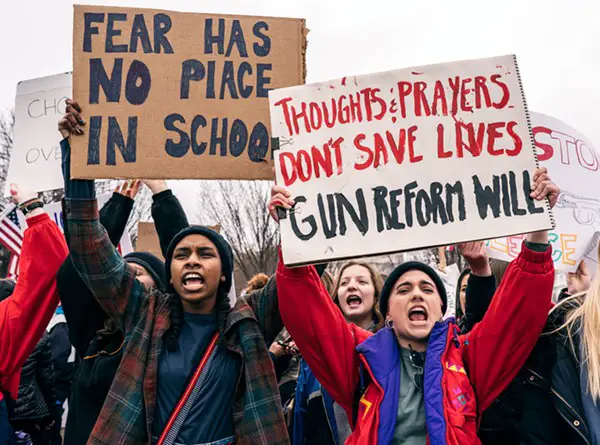On Feb. 14, Nikolas Cruz entered Marjory Stoneman Douglas High School with an AR-15 and killed 17 people. In the following days, the nation came together to mourn in what has become a disturbingly routine procedure.
Politicians express their grievances and then say that now is not the time to talk about gun control. Parents express their most heartfelt wishes that no other family has to go through what they are going through. Usually, nothing changes.
But this time, the narrative did change. Empowered students went to Washington. They held rallies and spoke out, demanding urgent change. Days after the shooting, President Trump suggested arming teachers and school staff. “If you had a teacher who was adept with the firearm, they could end the attack very quickly,” he said.
“Armed Educators (and trusted people who work within a school) love our students and will protect them,” Trump tweeted as a follow-up. “Very smart people. Must be firearms adept & have annual training. Should get yearly bonus. Shootings will not happen again – a big & very inexpensive deterrent. Up to States.”
President Trump recommended arming “the best” 20 percent of teachers. In a nation of approximately 3.1 million public school teachers and 400,000 private school teachers, this would mean arming around 700,000 teachers.
The President’s suggestion sparked an immediate wave of controversy. On one side, the NRA and its supporters loved the idea of arming teachers. On the other side, those worried about the dangers of having firearms in schools are pushing for different reforms.
Those who support arming teachers offer reasons revolving around issues of safety and timeliness. As NRA CEO Wayne LaPierre said following the 2012 Sandy Hook shooting in Newtown, “The only thing that stops a bad guy with a gun is a good guy with a gun.”
Proponents of this belief propose that arming teachers gives them a chance to protect students until law enforcement arrives. “We’re over 20 minutes from any police force being able to respond to an event, so with that in mind is one of the reasons why we decided to move forward [with arming employees],” Ryan Bruns, the Northwestern Area School District superintendent in South Dakota, told CNN.
When asked if schools should arm teachers, a student on Debate.org echoed Bruns’ sentiment. “Law enforcement can’t be trusted to show up in time to prevent a massacre,” they said. “I currently attend high school and I know that I would personally feel safer if my teachers were properly trained and carrying guns.”
In contrast, many argue that arming teachers is an unnecessary and dangerous. Instead, Americans should focus on limiting access to guns in the first place. To this end, proponents of gun control encourage raising the age limit on buying guns to 21 years old and banning bump stocks. Florida recently put both suggestions into legislation.
Opponents of arming teachers warn that, even if educators undergo training, there’s always the chance that something could go wrong. Vox reports that “Simulations have shown that even most people, if placed in an active shooter situation while armed, will not be able to stop the situation, and may in fact do little more than get themselves killed in the process.”
The FBI’s study of active shooter incidents between 2000 and 2013 says “Law enforcement suffered casualties in 21 (46.7%) of the 45 incidents where they engaged the shooter to end the threat.”
So law enforcement, trained to a higher degree than teachers, suffered casualties in nearly half of all cases. It goes without saying that teachers, who would have much less training, would be far more likely to get injured or even hurt a student by accident.
As a student just one year out of high school, the thought of any of my high school teachers with guns scares me. What if they panic and lose control? What if a student takes the gun and harms someone? But it’s not just high school I worry about.
I am a freshman in college in a country where there were 101 reported shooting incidents on or around college campuses during the 2015 – 2016 school year alone. Say that the mandate for armed teachers later extends to college professors.
In a setting where students are routinely anxious, depressed and drunk, I am not comforted by the idea of more guns on campus. What happens if a professor’s gun falls into the wrong hands?
In the interest of full disclosure, I should note that I am a white female who grew up in an area that, for the most part, was gun-free. I recognize that my race impacts my views on this issue. I also recognize that students of other races may have reason to worry about their personal safety far more than I do.
The Washington Post recently discussed the issue of race when arming educators, highlighting two potential issues: “(1) Arming teachers of black students who may have a racial bias, and (2) arming black teachers and education workers, who face their own risks carrying a weapon.”
That being said, students of color may feel even more unsafe knowing that someone is armed in an environment where they already face discrimination. Also, given the problems our country has with racially biased cops, a black educator with a gun may appear as a threat during a shooting.
In the coming days, the nation will watch as the issue of arming teachers is debated at the highest levels. Perhaps states will follow Florida’s example in raising the minimum age for buying guns or banning bump stocks. Perhaps we might begin arming teachers after all.
Either way, the next few months could bring some of the most impactful changes in gun control our nation has seen in a long time.

















